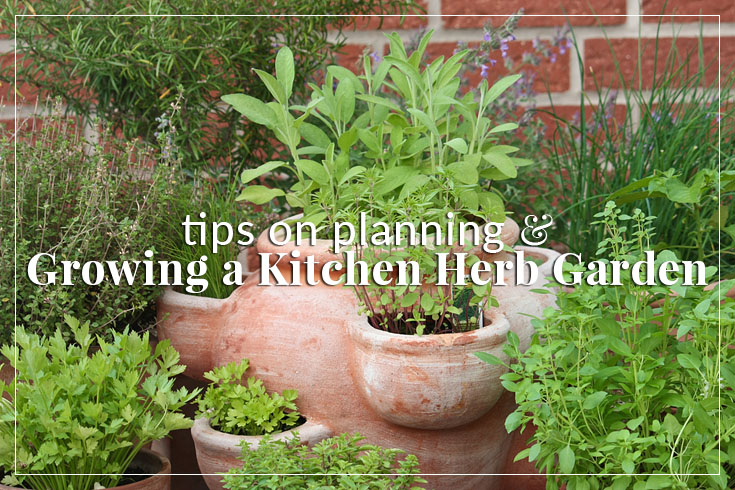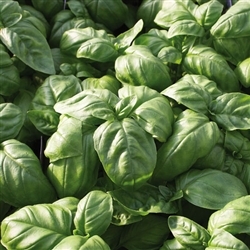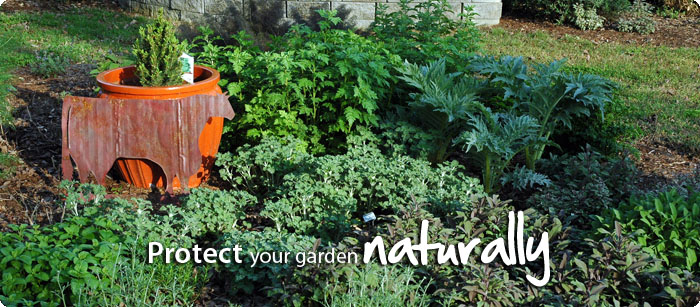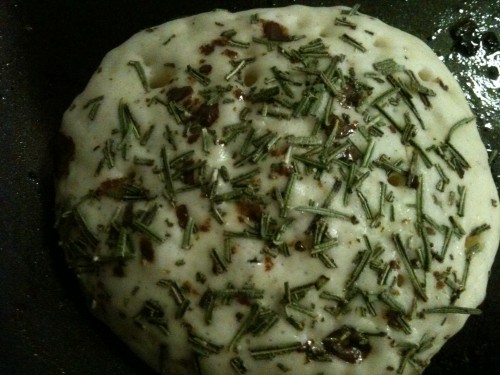by Herb Exchange | Feb 18, 2016 | Basics, DIY Gardening, Gardening |
Herb gardens are generally defined by the plants that are grown in them, so once you decide on the purpose of your garden, the next steps should flow fairly easily. After 30+ years of growing and selling herbs, we know that the majority of our customers are using their herbs in the kitchen, so we will start there!

Your Herb Garden Placement
The first step is deciding where to put your garden. The one rule of thumb that we always abide by: put your garden in easy reach of your kitchen. You are less likely to add that tablespoon of fresh marjoram if you have to trudge across the yard to the garden that you’ve tucked out of sight, behind the garage. Make use of the space right outside of your kitchen door; it should be as easy for the cook to head out of that door as to head into the pantry for the dried version of your herb. You don’t need a lot of space, and if you are really limited, then grow these culinary herbs in pots. A nice variety of culinary herbs can be grown in a 6’ x 6’ plot, although if you’ve got the space, go bigger and add some variety with annual flowers and veggies to make a real statement! In addition to location, you need to make sure that your garden will get enough sunshine as herbs need at least 6 hours of sunlight a day. Good draining soil is crucial, as well as healthy soil. And make sure that you have easy access to water. With the location sorted. During the winter months, the herbs won’t grow in very cold temperatures so it’s wise to store them in a safe and dry space. (more…)
by Herb Exchange | Jan 7, 2016 | Miscellaneous |
An herb, first and foremost, is a plant. It is a plant that can be used to flavor and garnish food, it can be food itself, utilized as a perfuming agent or made into homeopathic remedies for common illnesses and ailments. People from every society in the world and across time have used herbs to their benefit for all of the above reasons.
Humans and Herbs Intertwined
Most of the most ancient societies and peoples on the planet have used herbs and spices for food and medicine. Ancient Sumerians had healing practices that involved thyme and caraway. Ayurveda, an ancient Indian natural medicinal practice that is estimated to be almost 6000 years old, commonly used cinnamon, sandalwood and neem. Romans used herbs for medicine and anesthetics heavily in their empire. Native American knowledge of the uses and benefits of plants and herbs amazed European explorers who relied heavily on their local know-how to reap the same benefits. These cultures did not have modern medicine to rely on and the natural world had to be their medicine cabinet. Herbs have proved useful to all people and cultures. Listed below are some common herbs. However, their exact benefits might not be as well known.
Basil

A common ingredient and flavor in Italian cooking, basil has a unique flavor that many people are fond of. In addition to the culinary benefits, basil has some more things to bring to the table. In the event you are stung or bitten by a bug you can chew up fresh basil and apply it to the area to help lessen the pain. Ear infections can be mitigated with basil essential oil and basil tea can help regulate blood sugar and reduce stress. (more…)
by Herb Exchange | Jul 11, 2015 | Basics, Gardening |

You have put a lot of hard work into your garden, and now it is time to protect it! The biggest pest problem you face is insects, and the easiest way to prevent insect damage is to create an ‘unfriendly environment’. Your best defense is a HEALTHY GARDEN. Here are a few tips:
Clean up: make sure that you keep your plants clean by picking off any dead or dying leaves and stems. Make sure to get rid of weak plants and take all of the plant material away from the garden area. You want to keep weeds and debris out of the garden as that is a perfect spot for insects to breed. Keep your tools clean, and disinfect if you have been working with infected plants.
Dry Foliage: We want you to provide your plants with water, but it is important that you water in such a way that you keep the foliage dry. Wet, soggy foliage encourages fungal growth, as well as insect infestation. The best time of day to water is in the early morning, as that allows the foliage to stay dry for the majority of the day. Drip irrigation is a great method to water the root system while leaving the foliage dry.
Feed Them: We recommend a diluted feeding of seaweed fertilizer once a week. Although it is a bit smelly, seaweed contains trace elements of iron, barium, calcium, sulfur, zinc and magnesium to encourage healthy growth and give them the strength to fight any potential disease. Our favorite product is made by Neptune’s Harvest: http://www.neptunesharvest.com/fs-191.html
Use Them: The more you use them, the better. Spending time pinching back, pruning or harvesting is time well spent. Routine inspection of your herb plants is a good means of not letting anything get out of control, and it is also a great way to relax.
Plant Based Insecticides: In the event that you need use an insecticide, we recommend using a plant based product. Plants actually produce many powerful chemicals to defend themselves against insects. Pyrethrum is a safe and natural insecticide made from certain species of chrysanthemum, has relatively low toxicity and breaks down quickly.
by Herb Exchange | Jul 11, 2015 | Basics, Gardening, Pests and Problems |

We’ve all got someone on speed dial in the summer months to help with these annoying pest, just in case we’re unlucky enough to have an infestation of insects in our home. I know a few people who have added a fly screen to their double glazed windows, in the hopes of catching these flies before they enter the home. But what did people do before the existence of these specialized teams, and could we bring back some of these traditional methods when we can’t get hold of a pest control service? Throughout history, man has been plagued by insects. And, man has fought back. But, not with DEET or OFF, but inventive uses of plants, although if you wanted you could use DEET free bug spray to fight them off, but once upon a time these didn’t exist so we have to use something else. These plants are still effective, and a natural means of keeping modern man comfortable from the bites and annoyances of insects, especially in the summer months.
Here are a few popular options. Read more about them below:

Feverfew shares the same natural insect repelling qualities because it contains the same natural chemical, pyrethrin. Feverfew is known to repel moths, cockroaches, flies, ants, mosquitoes, mites, bedbugs and mice! It is best planted outside along paths and close to windows and doorways and around patios. It is especially effective when planted with citronella geraniums, lemon grass and lavender.

Known as Fleabane, works to repel ticks and fleas, as well as mosquitoes and gnats. Crushed pennyroyal leaves can be rubbed onto the skin as an effective insect repellent. Additionally, you can also rub the leaves on dogs to help repel fleas and ticks. But be careful, pennyroyal could potentially be toxic to your dog, so if they have been infested with fleas and ticks, you may want to have a look at these essential oils for fleas and ticks instead, so you can help them to be free from these insects, as well as protecting their skin and coats at the same time. But it can be used effectively for other things. Pennyroyal is often used in commercial natural insect repellent creams and sprays. Pennyroyal is great to plant in the garden, but it is best utilized as a topical insect repellent applied to the skin.

A member of the Mentha family, is known to deter mice and ants if planted around the foundation of the home. It is recommended that you identify the ‘trouble spots’ where the pests are entering the home, and plant 3 – 7 plants at each entry point. Shallow bowls of water filled with mint leaves placed in the pantry is also known to keep mice away.

is a great mosquito repellent. Planted in large containers on a deck, patio or by the pool it does deter most flying pests. In the landscape, it makes a lovely grass with the same repelling qualities. It is especially effective when planted in combination with Feverfew and Lavender.

is most useful for repelling mosquitoes and gnats when planted in the garden; it can also be planted in pots and placed by doorways and windows. As with feverfew and lemongrass, lavender is best planted in the garden around seated and eating areas and also around windows and doors. You can cut and dry lavender and place on windowsills to stop mosquitoes entering the house. Put dried lavender in closets to repel moths and keep clothes smelling fresh.

has a mixed reputation and it is hard to say whether or not this LOVELY and EASY TO GROW geranium is actually effective at warding off mosquitoes. It has the citronella scent, which leads one to believe that it has the active ingredient used in so many commercial products. However, there are those who say that it is as far as it goes, fragrance. In our own ‘tests’ we think that when the leaves are crushed and rubbed onto the skin, there is nothing better nor more fragrant at fighting those buzzing nuisances!
There are MANY more plants to help with pest issues.
Checkout our full selection of herbs & plants that help repel insects naturally.
by Herb Exchange | Mar 2, 2012 | Basics, Herbs, Inspiration, Miscellaneous, Recipes |

Our Marketing Director, Caroline, proves that fresh herbs can make even the worst frozen dish, fantastic!
As a struggling cook with little more than the ambition to want more than take-out every night, cooking can be hard. Probably the biggest thing you need to factor in is the budget and how much you can spend each week. A lot of people use their american express preferred credit card when paying for groceries so they can get big rewards they can use later on to make things more affordable. Cooking something that you’re actually excited to put on your plate can sometimes be even harder, if you’re a frugal yet resourceful, 20-something year old, like myself. So how do you get the most punch for your palate, while on a budget? Dress up inexpensive, everyday foods using fresh culinary herbs.
Between my indoor winter herb garden and the dried or frozen herbs I preserved from last year’s garden, I’ve been getting creative in my kitchen. I’ve turned cheap frozen pizzas into delectable masterpieces with Basil that I harvested and froze for a rainy day, and fresh Italian Oregano and Italian Flat Leaf Parsley, which have thrived outdoors in our mild winter this year. I’ve created every soup imaginable from canned pantry items, frozen veggies and English Thyme, Cutting Celery and Curly Parsley from my garden. And, most recently, I even conquered breakfast by adding freshly dried Rosemary ‘Salem’ to my instant pancakes to create one of my newest favorite foods. (To see WHERE I got these fresh Rosemary ‘Salem’ clippings, check out our video of our herb expert, Briscoe, teaching you how to hard prune your woody perennials!)
And while I was busy experimenting with a lot of herbs from my garden, I came across this book which was suggested by one of my friends. The book is called ‘The Plant Paradox Cookbook’ and it gives about 100 recipes, all of which could be used to lose weight and heal the gut. It also talks about the health benefits of living lectin-free. If you’re interested to find more about this book, check gundry md.
Herbs offer a terrific way to really jazz up your culinary routine, or if you’re cooking on a budget like me, they add tons of flavor and lots of valuable vitamins and nutrients to otherwise bland food. Don’t forget that your herb garden is a valuable investment that offers many flavorful rewards, so try experimenting with your favorite dishes by incorporating fresh herbs into your next meal and take your culinary skills from “ramen” to “righteous”! Check out our Cook’s Exchange for more herbal recipes, or try the one below.
After watching a Top Chef marathon and deciding it was time for brunch this past weekend, I tried my hand at some VERY creative pancake combinations. Luckily, a few of them were worth eating, so here’s one to try:
Caroline’s Accidentally Awesome Rosemary Pancakes

Ingredients:
- Instant Pancake Mix
- Water
- Oil
- Fresh Rosemary (pick your favorite, they’re all great!)
- Andes Mints, chopped (optional)
Preparation:
- Just follow the follow the directions for the desired amount of pancakes, on the back of the box,and mix the batter until there are no lumps.
- Add oil to your frying pan on medium-hot heat.
- Wash, dry and crush or chop the fresh Rosemary.
- Pour pancakes to desired size in your frying pan, and top with a generous sprinkle of Rosemary. (I was also making Andes Mint pancakes during this experiment, and some of the chocolate get mixed in with the Rosemary. It tasted terrific together, so for a sweeter pancake, try adding a little chocolate and Mint to compliment the Rosemary.)
- Cook til golden brown on both sides and eat until you’re full!












